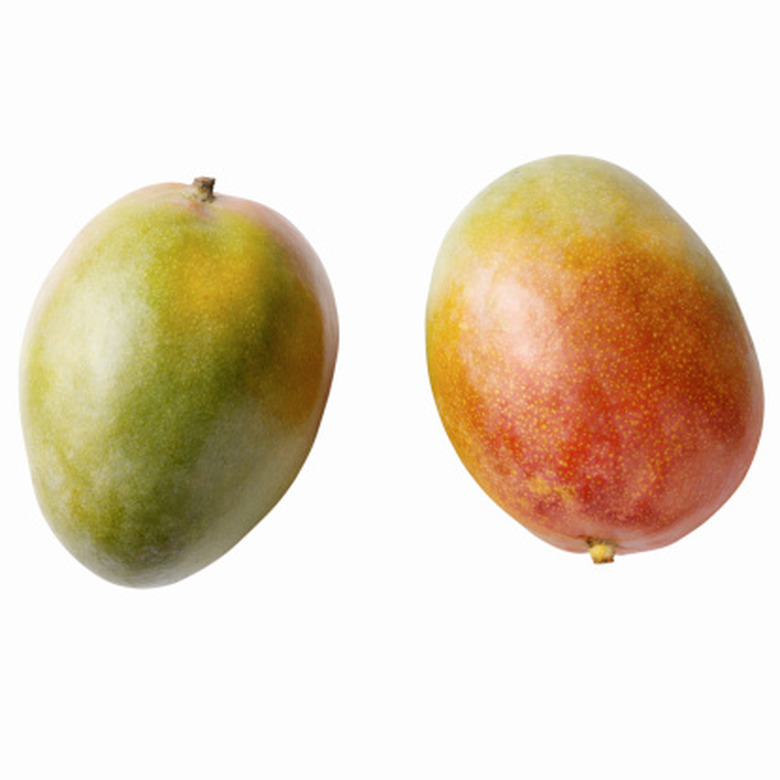What To Do If A Mango Tree Does Not Produce Fruit
Mango trees are broad-canopied evergreens that make excellent shade trees. But most people grow these tall, tropical-looking trees for their fruit. A healthy tree in the proper climate and location can produce large crops of juicy mangoes every year. If your mango isn't producing fruit, take steps to figure out the problem and solve it. Unfortunately, mangoes only thrive and fruit in frost-free climates, so if you are trying to grow mangoes outside in an area with cold winters, no amount of tinkering is likely to make those trees fruit. Low temperature during bloom time is one of the principal reasons a tree won't fruit. For people in warm regions where temperatures never ever dip below 40 degrees F., a solution is out there for your fruitless trees, if you keep looking.
Increase Sunlight and Air Drainage
Increase Sunlight and Air Drainage
All fruit trees need plenty of sunshine to fruit and the mango tree is no exception. Mangoes must have a full-sun location in order to flower and fruit. The tree also fruits best if it gets some air flow.
If your mango is not fruiting, check its location and exposure. It may be that the site received all-day sun when you planted the tree but, as time passed, nearby trees filled out and are now shadowing it. In that case, you'll want to prune down the neighboring trees to flood your mango with light. If the tree was simply planted in a shady spot to begin with, transplanting is the only solution. Move the tree to a location with at least six hours a day of direct sun, ideally at the top or middle level of a slope.
Apply Fungicide
Apply Fungicide
The mango tree needs hot, dry weather to set fruit. If your area is warm enough but rains a lot, your dreams of fruit-laden trees may be impacted by two diseases that impact fruiting of mango trees can affect fruiting, anthracnose and powdery mildew. Both are fungal diseases that show up in areas with high humidity when mango foliage remains wet for long periods of time.
Anthracnose is a disease that attacks the mangoes flower panicles. Look for black, irregularly shaped lesions. These will grow over time, resulting in leaf spot, rot or bloom blight, and ultimately preventing the tree from fruiting.
Powdery mildew is another mango malady that can inhibit fruiting. The disease is easy to recognize since it produces a pale, powdery fungus that covers mango blossoms and leaves. If the infection is bad enough, the flower panicles are destroyed. That makes it impossible for the tree to produce fruit.
If your tree has either of these diseases, that is likely the reason it isn't fruiting. You can prevent fungal diseases, including anthracnose and powdery mildew by applying a fungicide containing copper, carbamate, or benlate.
Limit Lawn Fertilizer and Irrigation
Limit Lawn Fertilizer and Irrigation
A mango tree surrounded by beautiful green lawn makes a lovely picture. However, it's not good for the tree since proximity to a cared-for lawn can result in too much fertilizer or water. And both overfertilizing and overwatering a mango tree can prevent the tree from fruiting.
Both the fertilizer and water you give to the lawn can be picked up by the mango tee's spreading roots. If you add nitrogen fertilizer to the lawn anywhere near the mango, it will absorb some of it, in addition to the regular applications of fertilizer you provide the mango itself during the period February through August. The result can be an overfertilized mango tree. For best fruit production, the mango tree must not get any fertilizer at all between the months of September and January.
For optimal health and fruit production, a mature mango tree (over four years old) shouldn't get much water except an occasional deep-watering during extremely dry periods. If you are using lawn sprinklers that deposit water anywhere near mango roots, the tree can suffer from overwatering that can limit fruit production or fruit quality.
